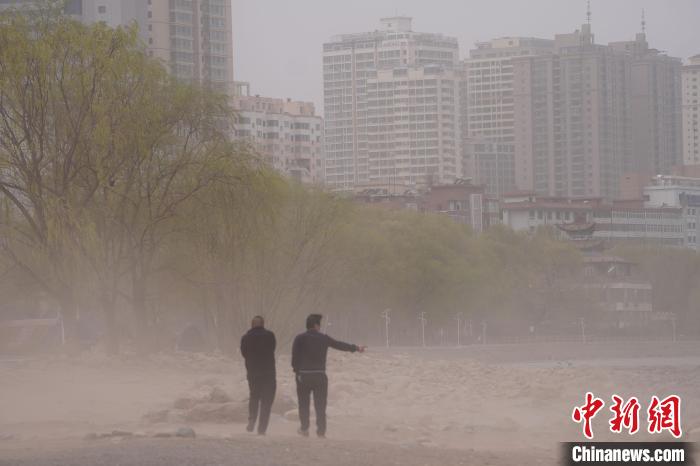China News Agency, Beijing, April 11 (Reporter Chen Su) Many places in northern China were hit by sand and dust weather on the 11th. What is the situation of sand and dust weather in China this spring?
Will the scene of "yellow sand filling the sky" be staged again?
Affected by a cold air, from the 10th to the 11th, sands appeared in the southern Xinjiang Basin, northern Qinghai, central and eastern Gansu, central and western Inner Mongolia, Ningxia, central and northern Shaanxi, western and northern Shanxi, western Hebei, and western Beijing. Or dusty weather, and local sandstorms occur.
Data map: Dust weather.
Photo by Jiumei Danzeng
On the morning of the 11th, the PM10 hourly concentration in Zhangjiakou City, Hebei Province increased significantly, reaching 800 micrograms per cubic meter, reaching a serious pollution level.
With the further southward pressure of the cold air, the sand and dust gradually affected Beijing. By 1 pm on the 11th, the PM10 concentration in Yanqing, Changping, Mentougou and other places in Beijing reached 300 micrograms per cubic meter. It is predicted that the peak concentration in some areas can reach moderate to severe pollution. level.
Gui Hailin, chief forecaster of the Central Meteorological Observatory, told a reporter from China News Agency that the dusty weather was the result of the combined influence of the Mongolian cyclone and the cold high pressure.
Large-scale windy weather formed in central and western Mongolia. On the evening of the 10th, large-scale sand and dust storms occurred in central and western Mongolia, western Inner Mongolia, and eastern Xinjiang. As the system moved eastward and southward, PM10 in many places in northern China increased rapidly. Raised, there is a dusty weather.
In March last year, northern China suffered the worst sand and dust storm in a decade, affecting about one-fifth of the country's land area. On March 15, 2021, Beijing was shrouded in yellow sand, with PM10 concentrations exceeding 2,000 micrograms/g in most areas. Cubic meters, Haidian Sijiqing Station reached 3572 micrograms per cubic meter.
Will there be "yellow sand in the sky" in China this spring?
Statistics released by the China Meteorological Administration earlier this month show that since the beginning of this year, there have been two sand-dust weather processes in China, namely the sand-blowing weather process from March 3 to 5 and the sand-blown weather process from March 13 to 16. The sandstorm weather process is significantly less than the average of the same period of the year (4.9 times), and significantly less than the same period of 2021 (6 times).
Gui Hailin said that the formation of sandstorms requires surface conditions. From February to March this year, the surface conditions were slightly better than last year. With more precipitation, the sand conditions would be worse. Another more critical factor is that this year's The weather system is not as strong as last year. Last year, the sand and dust weather was severe, and it was mainly affected by the strong Mongolian cyclone. This year, the Mongolian cyclone and cold air are not as strong as last year, and there is no area with large-scale continuous strong winds.
According to the forecast, the overall intensity of the dust weather this spring will be weaker than last year.
He said that with the continued effect of strong northwesterly winds, it is expected that the current round of sand and dust processes will tend to weaken from the evening to the night of the 11th.
It is expected that there will be no strong sand and dust weather in the next week.
However, looking at this spring, there will still be a high probability of sand and dust weather affecting the eastern region in the later period, but the overall intensity will be lighter than last year.
Regarding the anomalous sand and dust weather in China last year, some people believe that "China has entered a period of frequent sand and dust storms." From a longer time perspective, is China's sand and dust weather increasing?
Gui Hailin said that at present, there is no obvious sign that China has entered a period of frequent sand and dust. Last year's severe sand and dust weather was related to extreme weather under the background of global warming. Under the background of global warming, extreme weather phenomena have increased. The intensity of severe weather is greater, such as extremely severe sandstorms and floods, but the frequency does not necessarily increase, so it cannot be said that China has entered a period of frequent sandstorms.
Meteorological experts remind that for the dusty weather in northern China in spring, it is necessary to make preparations for wind and sand prevention, close doors and windows in time, and pay attention to wearing masks, gauze and other dust-proof items when going out. Place outdoor items that are easily affected by sand and dust storms. When visibility is low, drivers should control the speed to ensure traffic safety.
(Finish)

